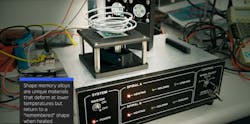Heat-Activated Shape-Shifting Antenna Built with Unique Material and 3D Printing
What you’ll learn:
- How a special nitinol compound and 3D printing was used to create the shape-shifting antenna.
- An overview of materials and heating problems they encountered, and how they overcame them.
- The test arrangement and performance achieved with this antenna implementation.
The concept of a physically reconfigurable antenna isn’t new, but making it happen is a challenge. Now, a novel antenna whose shape can be changed solely by running a heating current through it has been built and tested by a cross-disciplinary collaborative team at the Johns Hopkins University Applied Physics Laboratory (JHUAPL).
This could enable a single physical antenna to serve multiple bands and offer differing propagation characteristics without a need for a motor or other tangible actuator. (Note that the motion is relatively slow, and this antenna isn’t going to replace electronically steerable antennas or MIMO arrangements.)
The team demonstrated the initial steps by showing a wideband reconfigurable compound (WRC) antenna that can work across multiple frequency bands, antenna directional patterns, and gains. To make it happen, they took advantage of recent advances in two-way shape-memory-alloy (AM-SMA) technology used for additive manufacturing (Fig. 1).
Their antenna is an 8-cm-diameter double spiral made of nitinol. which seems like an obvious material to use to meet the reconfigurable objective. However, that insight is only a small part of the project.
[In case you have forgotten: Nitinol (NiTi) is a nearly equiatomic metal alloy of nickel and titanium with unique properties, including superelasticity (also called pseudoelasticity) and shape memory when heated and cooled. It’s widely used in medical devices such as stents, orthodontic wires, surgical instruments, and orthopedic implants, as well as other applications. Varying the proportion of the nickel versus titanium gives the material different mechanical properties and thermal sensitivities.]
Paths Abandoned, Paths Followed
One interesting thing about the team’s paper is that it discusses some of the problems they faced and how they overcame them rather just saying, “We did this, then we then that, and we ended up with this.” That part of the story was especially insightful and informative.
The antenna was modeled in both flat- and conical-spiral configurations. And the antenna element was integrated with a multipurpose dielectric stack-up for cable routing, convective cooling, and RF mitigation purposes. The prototype antenna was modeled and then validated from 4 to 11 GHz (S to X bands) with a gain of approximately 5 dBi (Fig. 2).
Each layer was made with airflow channels to convectively cool the spiral antenna and support an efficient transition from its heated conical configuration to its cooled flat configuration. Further, a central cable routing feature was also machined into the stack-up for integration with the assembled PCB-mounted, AM-SMA spiral antenna. That routing feature provided clearance for the surface-mount components attached underneath the PCB and enabled RF cables to be fed through the stack-up to drive the antenna.
While trying to turn this idea into reality, they encountered issues with both processing the basic nitinol material into an antenna as well as heating and cooling it for reconfiguration:
On the material side:
Nitinol and other shape-memory alloys generally require extensive mechanical processing—called “cold work”—to achieve the shape-memory effect. As a result, they’re typically only available as wire or in thin sheets. But doing an extreme amount of cold work would defeat the whole point of the project, since passing a complex shape through a die to stretch it out takes it back to just being a wire.
After extensive experimentation, the team altered the ratio of nickel and titanium. However, the first attempt to create a shape-shifting horn antenna using 3D-printed nitinol fell short. While the antenna did technically expand and contract and change its frequency, it was also rigid and difficult to expand. After further trials, they managed to develop an antenna that was shaped like a flat spiral disk when cool, but it became a cone spiral when heated.
Another piece of the puzzle was working out how to 3D-print the antenna in a consistent, repeatable fashion. Their modified nitinol, with its higher concentration of nickel versus titanium, made it challenging to print at scale.
“We have a lot of experience optimizing processing parameters and designs for alloys, but this was a step beyond,” explained one team member. “There aren’t many people out there, if anyone, printing this material, so there’s no recipe for how to process it. We made shrapnel in the printer a few times because the antenna is trying to change shape as you’re printing it, due to the heat.”
Temperature transition:
Thermal actuation of NiTi while maintaining the antenna’s performance was also a challenge. They first used hot air blowing over the AM-SMA antenna, which worked well but had a serious drawback—the large amount of energy required to reach the transition temperature of the NiTi. The transition temperature of the NiTi SMA can be tuned to actuate at higher temperatures such as 60°C. This enabled the use of ambient environmental temperatures for cooling even when in hot environments (provided the antenna is shielded from direct sunlight).
They considered putting a hot-air convection heater at the base of the antenna. This approach was discarded, though, when simulations showed that it would impractically take hours to affect the transition, even if heating the base to over 1000°C.
The next option was direct-current I2R heating of the antenna coil. However, this would also require an inductor to isolate the RF from the heating-current supply, which, in turn, created a new challenge as available inductors aren’t capable of supporting amps of current at frequencies above 2 GHz.
Instead, they devised an innovative method of using a coaxial-geometry transmission line, creating an RF impedance-mismatch boundary to isolate the DC line from the RF line at the base of the antenna. In addition, direct proximity of the DC return line along the AM-SMA antenna allowed the entire DC-current path to look transparent to the RF-current path due to the high capacitance seen between the two lines.
This elegant yet simple solution performed well, with only approximately 1% of the RF power being leaked through (as determined using a S21 measurement) without additional optimizations.
Performance Matters: The Test Setup
To “field test” their design, a PCB-mounted, AM-SMA spiral antenna element was integrated into its respective dielectric stack-up and attached to a test fixture. A balun was used to maintain a 50-Ω input into the antenna, and 1-μF DC blocking capacitors on the antenna element side were applied to prevent DC current from flowing through the balun. Pyramidal dielectric absorbers lined the compact range to mitigate extraneous RF reflections and isolate antenna performance. In addition, magnetic RF absorbing material (MagRAM) was applied to the sides of the metallic test fixture during the experiment to mitigate any scattering from that source.
The fully assembled prototype was electrically characterized in a compact antenna range, with the test fixture secured to a positioner for spatial measurements (Fig. 3). The antenna element was tested in both flat and conical configurations. A DC power supply was connected to the prototype for resistive heating to enable a transformation from the flat configuration to a conical configuration.
While many parameters characterize performance, one set of results in shown in the three-panel image (Fig. 4). Other results are called out in their published paper.
The project is described in detail in “Two-Way Additively Manufactured Shape Memory Alloy Wideband Reconfigurable Compound Antenna,” published in ACS Applied Engineering Materials. At the end of the paper is a Supporting Information posting. Unlike many such addendums telling you details that are important to document but not of direct relevance to the reader, this file is packed with useful and interesting information.
A somewhat hypnotizing one-minute video shows the antenna extending and retracting as it is heated and cooled, respectively:
About the Author

Bill Schweber
Contributing Editor
Bill Schweber is an electronics engineer who has written three textbooks on electronic communications systems, as well as hundreds of technical articles, opinion columns, and product features. In past roles, he worked as a technical website manager for multiple topic-specific sites for EE Times, as well as both the Executive Editor and Analog Editor at EDN.
At Analog Devices Inc., Bill was in marketing communications (public relations). As a result, he has been on both sides of the technical PR function, presenting company products, stories, and messages to the media and also as the recipient of these.
Prior to the MarCom role at Analog, Bill was associate editor of their respected technical journal and worked in their product marketing and applications engineering groups. Before those roles, he was at Instron Corp., doing hands-on analog- and power-circuit design and systems integration for materials-testing machine controls.
Bill has an MSEE (Univ. of Mass) and BSEE (Columbia Univ.), is a Registered Professional Engineer, and holds an Advanced Class amateur radio license. He has also planned, written, and presented online courses on a variety of engineering topics, including MOSFET basics, ADC selection, and driving LEDs.




